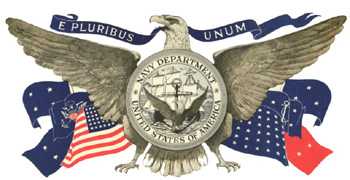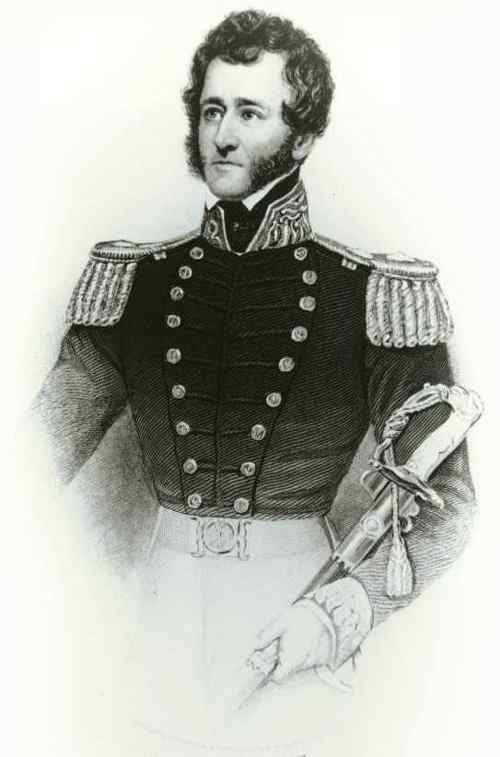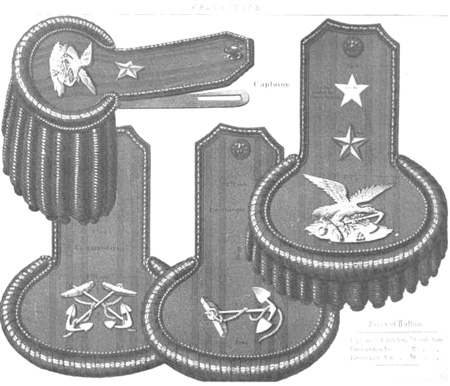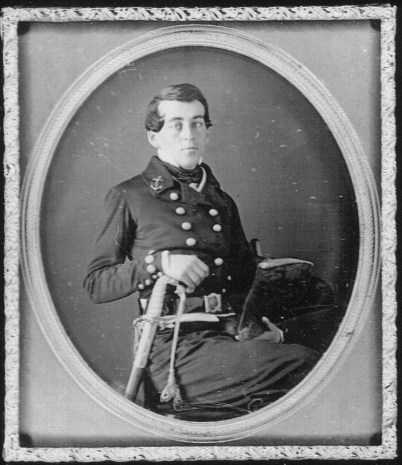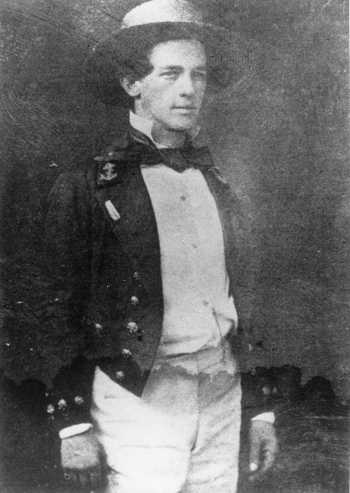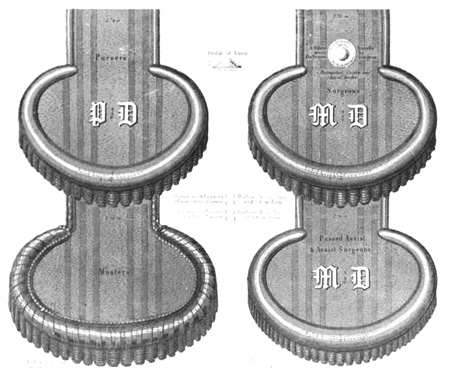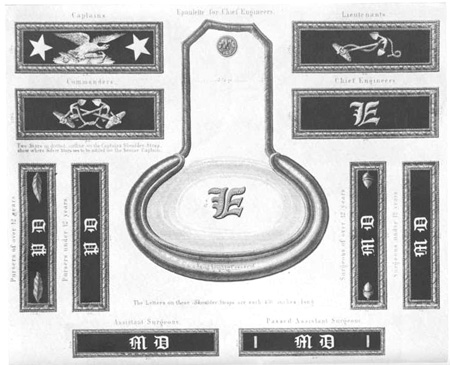![[Aztec Club Logo]](Aztec7.gif)
| American Forces |
|
| Mexican Forces |
|
| Main Menu |

The 1841 regulations
expanded the system of showing some form of rank device on
epaulets. Previously, only a commodore had been assigned
a device -- a silver star. The new regulations directed all
captains to wear a plain silver anchor and eagle on epaulets,
and commodores a star above the anchor-eagle device. These regulations also
expanded the shoulder-strap system to incorporate some indication
of rank. Captains were instructed to wear blue cloth straps, two
and a half inches long and half an inch wide,
with gold-embroidered edges. Commodores displayed the star in the
center of the straps; for captains the straps
were plain. Commanders and lieutenants wore gold lace straps, the
same size of those for captains, but without devices. Since lieutenants were entitled to
but one epaulet, they wore the strap on the
right shoulder. From this humble beginning was developed the U.
S. Navy's system of shoulder straps which came into full use
during the Civil War.
All officers except professors, clerks, and the forward warrant officers were permitted to wear cocked hats. The excepted officers wore blue cloth caps with blue bands. The use of bullion loops over the cockades introduced in 1830 was expanded. Captains and commanders retained the loop of six bullions, the center pair twisted; lieutenants, masters, and passed and other midshipmen now had a look of four bullions, the center pair not twisted. Just before the Mexican War, in 1845, uniform regulations were modified authorizing lieutenants to wear two plain gold epaulets. Commanders were directed to wear a plain silver anchor device. Captains other than those in command of a squadron now displayed a silver spread eagle.
The Navy's first cap device, the anchor and star for midshipmen and the anchor for midshipmen, were removed from the front of the blue cap. All midshipmen were now permitted to wear a gold lace band an inch and a half wide, the same as authorized for captains, commanders, and lieutenants.
Lighter-weight frock (undress) coats of "dark blue summer-cloth" were authorized for warm climates and straw hats were permitted. The body of the hat was to be six inches high, and the brim three and a half inches wide.
The assignment in 1846 of relative rank to medical officers, and in 1847 to pursers, led to further modifications by order of Secretary of the Navy John Mason on May 27, 1847. Now medical officers and pursers were permitted to wear epaulets similar to those of the sea officers with whom they had been given relative standing. However, the epaulets were of a different pattern, for the crescents were to be solid and bright, instead of embroidered. The bullions of the epaulets of surgeons and pursers of more than twelve years' standing were to be the same as those of commanders with whom they ranked, a half inch in diameter and three inches long. For surgeons and pursers of less than twelve years' service, the bullions were to be like those of lieutenants -- three inches long, but only three-eighths of an inch in diameter. Passed assistant surgeons had the relative rank "next after lieutenants" -- that is, with masters. Assistant surgeons ranked "next after masters", or with second masters. As neither masters nor second masters wore epaulets, the Navy Department specified that the assistant surgeons wear the same type as their seniors, but with bullions a quarter of an inch in diameter. Within the crescents of the epaulets, all medical officers displayed the initials of the Medical Department, M.D., in Old English characters, worked in solid silver. Pursers wore the letters P.D. in Old English characters to indicate their department. "Surgeons of the Fleet" were identified by a rosette of burnished silver on the strap above the letters.
Since all officers entitled to wear epaulets wore shoulder straps to indicate their rank when epaulets were omitted, all medical officers and pursers were directed to wear straps of blue cloth with a gold-embroidered edge. The straps of surgeons and pursers had a quarter-inch border of embroidery, those for the passed assistant and assistant surgeons had a border an eighth of an inch in width. Medical officers displayed the letters M.D. in silver in the center of the straps. To indicate classes of medical officers, devices were employed. "Surgeons of the Fleet" had a silver rosette at the strap ends. Surgeons of more than twelve years' service had a silver acorn at each end of the strap; surgeons who had served less than twelve years had no end devices. Passed assistant surgeons had a silver bar at each end of the strap; the bars were omitted for assistant surgeons. The senior pursers showed the P.D. in the center; with an oak leaf at either end. Pursers of less than twelve years' service wore the departmental letters without end devices. Both the silver bars and oak leaves introduced by the order of May 27, 1847 have come down to the present day U. S. Navy as rank insignia.
The diagram below depicts the Navy officer undress shoulder straps as of 1852 which provide an idea of how shoulder straps appeared during the Mexican War. Purser Department, with and without acorn devices, and Medical Department, with and without acorn devices, are seen lower left and right, respectively. Passed assistant surgeons, bottom right, wore the same shoulder straps as assistant surgeons, lower left, with a gold bar at either end, shown below.
|
|
Next Page | Return to Main Menu webmaster@aztecclub.com Page Last Modified: 26 August 2000
Copyright Notice Copyright © 2006, 2012. All Rights Reserved.
|
